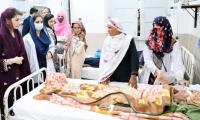A few weeks ago, a dozen children in Turbat suffered severe burn injuries when a kerosene cylinder exploded at a roadside stall. Baby Shazia from Thar was only 11 days old and had second degree burns on her face from a mosquito coil placed too close to her. These are only a few of the thousands of cases of children who become annual burn statistics because of poverty, ignorance and neglect.
Shazia and that bus load of young children from Turbat – and many other such cases – had all been rushed to the Burns Centre located within Civil Hospital in Karachi. This 65-bed facility is the only properly equipped burns unit in a city of 20 million people since larger hospitals lack dedicated burns wards. This could be related to the fact that very high mortality rates in burn injuries make these the most challenging to treat. Even with specialized attention, nearly 40 percent of the total number of patients admitted to the Burns Centre over the past 14 years did not survive their injuries.
The centre runs on a private-public partnership model, providing free of charge service under the vigilant oversight of a group of committed philanthropists, treating cases that can move even the most experienced care-givers. Survivors of burn injuries never really recover from the physical or emotional scars they carry for the rest of their lives but the centre holds out some hope to its patients through treatment, counselling and physiotherapy as they learn to deal with a different reality involving scarring, loss of limbs and prosthetics.
During the first six months of 2019, around 10,346 patients have been brought to the centre, of whom 4,208 are young children. Too many of these burn injuries are entirely preventable and can be reduced through better awareness of risks and by ensuring higher safety standards at home and outside.
A disproportionately high number of gas burns and scalding cases are of women who are forced to use primitive and unsafe stoves for cooking. Women also rank much higher in suicide rates and are more likely to be victims of crime. Shamim (name changed to protect identity) was brought to the centre because of an ‘exploding stove’. She survived long enough to inform the police of being doused in kerosene oil and set on fire. While acid burns amongst men are mostly work-related accidents, women are more likely to suffer these at the hands of men who react to feelings of anger, rejection or frustration by disfiguring their targets. The reasons for such brutal treatment could be anything, from not producing a child to not bringing dowry or judged unfaithful to the husband.
According to a WHO report, 70 percent of total burn victims in South Asia are women. However, statistics indicate that Pakistan has relatively more gender balanced numbers in burn casualties. One large contributing factor that impacts more men than women is extremely poor safety standards in factories and places of work, leaving low-level workers at greater risk of death or injury. An example would be small furnaces and steel melting operations that regularly operate without any proper regulations or inspection.
We need to ask hard questions because there is a common theme of deteriorating cultural and ethical values in all these stories. The system allows the most vulnerable segments of society, children, women and the poor to live without safety nets. For example, why is acid easily available despite the fact that countless cases of hate crime are attributed to its misuse? Are factories and shops and other places of work ever checked for safety standards? And finally, why are women treated worse than animals in a society that takes pride in being Muslim?
While the Burns Centre can do with generous donations for treatment and rehabilitation of patients, the stories of the victims that come there point at deeper issues within our society that need to be addressed if we want to be part of the civilized world where children go to school and don’t get electrocuted while trying to climb electric poles for a 'kunda' connection.
The writer is a freelance contributor. Email: nadiraziz@live.com
After November 30, it will be impossible for ordinary internet users to access all banned websites, including X
Muslims participated alongside their Hindu fellow villagers and other residents of area
For last eight years, HEC's budget has been virtually stagnant in absolute terms
Home to 14 million people, Lahore has always been celebrated as Pakistan’s historical, culinary, and cultural hub
Partnership between Pakistan and China in media and culture reflects shared commitment to strengthening bilateral...
This article focuses on single error committed by our respected judiciary which haunts me more than I would care to...







